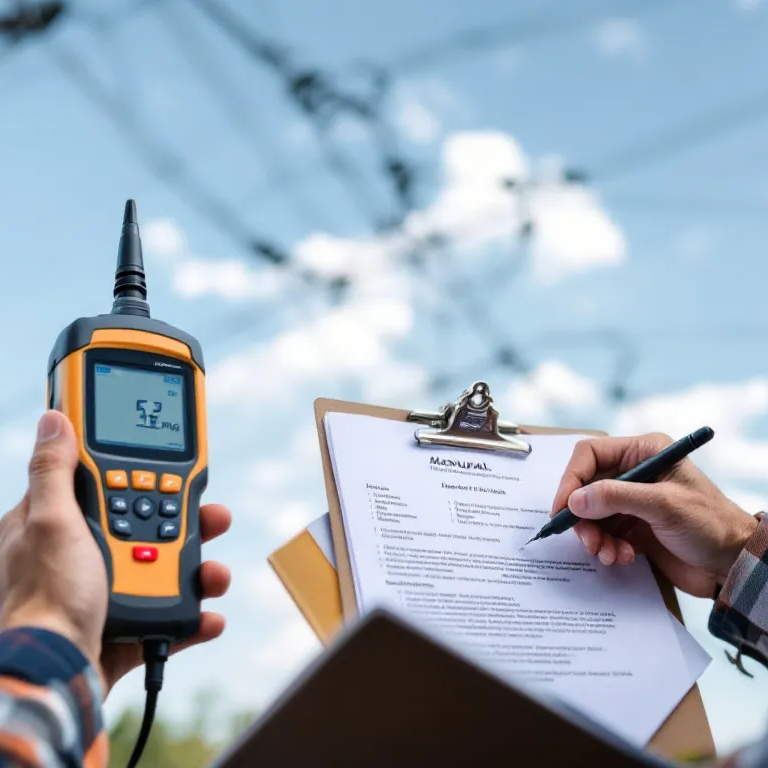Minimierung elektromagnetischer Felder vom Computer: Effektive Strategien für einen sichereren Arbeitsplatz
Besorgt über die elektromagnetische Strahlung Ihres Computers? Dieser Artikel erklärt es. EMF-Quellen im Computerbereich, mögliche gesundheitliche Auswirkungen und wie man die Exposition minimieren kann.
Die wichtigsten Erkenntnisse
-
Elektromagnetische Felder (EMF) von Computern entstehen durch Quellen wie Netzteile, Lüfter und drahtlose Kommunikationssysteme, weshalb man sich ihrer Anwesenheit und ihrer Auswirkungen bewusst sein muss.
-
Verlängert Exposition gegenüber elektromagnetischen Feldern kann zu gesundheitlichen Problemen wie Müdigkeit, Schlafstörungen und potenziellen Fruchtbarkeitsrisiken führen, was die Bedeutung der Reduzierung der Exposition am Arbeitsplatz unterstreicht.
-
Durch die Umsetzung von Strategien wie dem Einhalten sicherer Abstände, der Verwendung kabelgebundener Verbindungen und dem Einsatz von Erdungsgeräten lässt sich die Belastung durch elektromagnetische Felder wirksam minimieren und die Sicherheit am Arbeitsplatz erhöhen.
Verständnis der elektromagnetischen Emissionen von Computern
Elektromagnetische Felder (EMF) sind allgegenwärtig, aber was genau sind sie? Im Kontext von Computern handelt es sich hauptsächlich um elektrische Felder, Magnetfelder und Hochfrequenzfelder (HF-Felder). Diese Felder entstehen als Nebenprodukt der elektronischen Bauteile und der drahtlosen Kommunikationstechnologien, die unsere Geräte so leistungsstark und vielseitig machen.
Elektrische und magnetische Felder von Computern entstehen hauptsächlich durch Komponenten wie Netzteil und Motherboard. Hochspannungskomponenten, beispielsweise Netzteile, erzeugen niederfrequente elektrische Felder, während der Betrieb von Lüftern und anderen Elektromotoren niederfrequente Magnetfelder erzeugt. Diese Felder sind in Desktop- und Laptop-Computern allgegenwärtig, weshalb es unerlässlich ist, ihre Ursprünge und Auswirkungen zu verstehen.
Andererseits erzeugen Computer Hochfrequenzstrahlung, wenn WLAN und Bluetooth aktiviert sind. Mit dem Aufkommen von 5G und anderen drahtlosen Kommunikationstechnologien sind diese hochfrequenten Felder häufiger geworden. Diese Hochfrequenzfelder sind Teil des breiteren elektromagnetischen Spektrums und tragen, einschließlich nichtionisierender Strahlung, erheblich zur gesamten elektromagnetischen Belastung in modernen Arbeitsumgebungen bei.
Das Verständnis dieser Emissionen ermöglicht es uns, fundierte Maßnahmen zu ergreifen, um die Belastung zu minimieren und eine sicherere Umwelt zu schaffen.
EMF-Quellen in PCs
Bei PCs gibt es zahlreiche Quellen elektromagnetischer Felder. Lüfter beispielsweise nutzen Elektromotoren, die elektromagnetische Felder erzeugen. Diese Lüfter sind zwar unerlässlich für die Kühlung unserer Systeme, tragen aber während des Betriebs zur Gesamtbelastung durch elektromagnetische Felder bei. Die von diesen Elektromotoren erzeugten niederfrequenten Magnetfelder sind in unserer Computerumgebung permanent vorhanden.
Drahtlosnetzwerkmodule in Computern stellen eine weitere bedeutende Quelle elektromagnetischer Felder dar. Diese Module emittieren beim drahtlosen Datenaustausch Hochfrequenzstrahlung, wobei die Emissionen mit der aktiven Datenübertragung zunehmen. Dies ist insbesondere für Nutzer relevant, die häufig auf drahtlose Internetverbindungen oder Bluetooth-Geräte angewiesen sind.
Die internen Komponenten eines Computers, wie Netzteil und Motherboard-Schaltkreise, erzeugen ebenfalls elektrische und magnetische Felder. Diese Komponenten sind zwar für die Funktion des Computers unerlässlich, tragen aber leider zur gesamten elektromagnetischen Strahlung bei. Die Kombination der Emissionen von Lüftern, Funkmodulen und internen Komponenten macht PCs zu einer bedeutenden Quelle elektromagnetischer Felder.
Die Identifizierung dieser Quellen hilft dabei, die Bemühungen auf Folgendes zu konzentrieren: Reduzierung der EMF-Belastung , wodurch Computerumgebungen sicherer und gesünder werden.
Gesundheitliche Auswirkungen einer längeren Exposition gegenüber elektromagnetischen Feldern
Längere Exposition gegenüber elektromagnetischen Feldern kann verschiedene gesundheitliche Auswirkungen haben, darunter Müdigkeit und Kopfschmerzen. Diese Symptome können die tägliche Produktivität und das allgemeine Wohlbefinden erheblich beeinträchtigen und aus einer anfänglichen kleinen Unannehmlichkeit ein chronisches Problem machen.
Auch die Schlafqualität wird durch elektromagnetische Felder (EMF) beeinträchtigt. Studien haben gezeigt, dass EMF den Schlaf negativ beeinflussen und potenziell zu Schlafstörungen führen können. Schlafmangel kann weitreichende Folgen für die Gesundheit haben und alles von der kognitiven Funktion bis zur emotionalen Stabilität beeinträchtigen. Der Zusammenhang zwischen EMF-Belastung und Schlafproblemen unterstreicht die Notwendigkeit eines Schlafumfelds mit geringer EMF-Belastung. Umfeld.
Ein weiteres Problem ist der mögliche Einfluss auf die Fruchtbarkeit. Studien deuten darauf hin, dass die Belastung durch elektromagnetische Felder (EMF) das Risiko von Unfruchtbarkeit, insbesondere bei Männern, erhöhen kann. Darüber hinaus kann eine längere EMF-Belastung die Immunfunktion schwächen und so die Anfälligkeit für Krankheiten erhöhen. Ein geschwächtes Immunsystem macht anfälliger für verschiedene Erkrankungen und Infektionen.
Erhöhter oxidativer Stress durch elektromagnetische Felder und ionisierende Strahlung kann normale Zellfunktionen stören. Hohe Konzentrationen freier Radikale, die durch elektromagnetische Felder ausgelöst werden, können zu Zellschäden und Apoptose führen. Diese Zellstörungen können langfristig schwerwiegendere Gesundheitsprobleme nach sich ziehen, weshalb Vorsichtsmaßnahmen unerlässlich sind.
Reduzierung der EMF-Belastung durch Computerbildschirme
Eine der einfachsten Möglichkeiten, die Belastung durch elektromagnetische Felder von Computerbildschirmen zu reduzieren, ist die Einhaltung eines angemessenen Abstands. Für Laptops wird ein Sicherheitsabstand von mindestens 30 cm empfohlen, während für Desktop-Monitore ein Betrachtungsabstand von mindestens 51 cm ideal ist. Bei größeren Flachbildschirmen kann auch ein Abstand von der halben Bildschirmdiagonale die Belastung verringern.
Eine weitere wirksame Strategie ist die Reduzierung der Bildschirmhelligkeit und der Hintergrundbeleuchtung, wodurch die ELF-Emissionen von LED-Bildschirmen verringert werden können. Zusätzlich kann die Positionierung des Computerbildschirms fernab von hellen Lichtquellen die Blendwirkung verringern und den Sehkomfort erhöhen, wodurch die Augenbelastung reduziert wird.
Für Vielnutzer von Laptops wird die Verwendung kabelgebundener externer Bildschirme dringend empfohlen. Insbesondere LCD- und LED-Bildschirme erzeugen im Vergleich zu anderen Bildschirmtypen weniger elektromagnetische Strahlung. Darüber hinaus lassen sich unnötige Quellen elektromagnetischer Strahlung vermeiden, indem man WLAN und Bluetooth deaktiviert, wenn sie nicht benötigt werden.
Durch die Umsetzung dieser Strategien kann die EMF-Belastung durch Computerbildschirme deutlich reduziert werden, wodurch der Arbeitsplatz sicherer und komfortabler wird.
Kabelgebunden vs. kabellos: Auswirkungen auf die EMF-Werte
Die Wahl zwischen kabelgebundener und drahtloser Internetverbindung hat einen erheblichen Einfluss auf die EMF-Belastung. Die Nutzung einer kabelgebundenen Internetverbindung kann die EMF-Belastung durch Laptops deutlich reduzieren. Kabelgebundene Verbindungen eliminieren nicht nur Hochfrequenzstrahlung, sondern bieten im Vergleich zu drahtlosen Verbindungen auch höhere Internetgeschwindigkeiten und eine größere Zuverlässigkeit.
Ethernet-Kabel beispielsweise können bis zu 100 Meter weit übertragen werden, ohne dass es zu Geschwindigkeits- oder Qualitätseinbußen kommt. Sie bieten eine stabile Verbindung, die Störungen durch andere drahtlose Netzwerke und Geräte minimiert. Diese Stabilität ist besonders vorteilhaft für Anwendungen wie Videokonferenzen, die eine konstante und zuverlässige Verbindung erfordern.
Andererseits können WLAN-Router die Frequenzbänder überlasten, was die Leistung beeinträchtigt und zu langsameren Verbindungsgeschwindigkeiten führt. Auch die Entfernung zum WLAN-Router beeinflusst die Signalstärke; eine größere Entfernung kann die Belastung deutlich reduzieren. Mit kabelgebundenen Alternativen schaffen Sie eine effizientere und sicherere Computerumgebung.
Die Entscheidung für eine kabelgebundene Internetverbindung kann die Internetleistung verbessern und die Belastung durch elektromagnetische Felder deutlich reduzieren, was sie zu einer Win-Win-Lösung macht.
Sichere Verwendung von Laptops und Desktop-Computern
Die richtige Positionierung und Nutzung von Laptops und Desktop-Computern kann die Belastung durch elektromagnetische Felder deutlich reduzieren. Beispielsweise sollte der Laptop auf einem Tisch statt auf dem Schoß platziert werden. Ebenso wichtig ist es, Laptops und Desktop-Computer in ausreichendem Abstand zum Körper zu halten, um die Belastung durch elektromagnetische Felder zu minimieren.
Die Verwendung einer externen Tastatur und Maus kann die Belastung ebenfalls reduzieren, da der Laptop dadurch weiter entfernt aufgestellt werden kann. Auch die Verwendung externer Monitore kann die EMF-Belastung bei der Arbeit am Laptop weiter minimieren. Kabelgebundene Tastaturen und Mäuse werden insbesondere für elektrosensible Personen empfohlen, um die Belastung durch niederfrequente elektromagnetische Strahlung zu verringern.
Eine ordnungsgemäße Kabelführung, beispielsweise durch das Verlegen von Elektrokabeln und -geräten fernab vom Körper und deren Anordnung an einer Wand, kann die Belastung durch elektromagnetische Felder weiter reduzieren. Kabel so weit wie möglich vom Körper entfernt zu halten, ist eine weitere einfache, aber wirksame Maßnahme.
Wenn Sie darauf achten, dass Tastatur und Maus auf Ellbogenhöhe positioniert sind, können Sie Belastungen und die Exposition gegenüber elektromagnetischen Feldern reduzieren. Indem Sie diese Richtlinien befolgen, schaffen Sie einen sichereren und ergonomischeren Arbeitsplatz, minimieren Ihre EMF-Belastung und verbessern Ihr allgemeines Wohlbefinden.
Erden Sie Ihre Geräte, um elektromagnetische Felder zu reduzieren.
Durch Erdung lässt sich die Belastung durch elektromagnetische Felder effektiv reduzieren, indem die Abschirmung des Laptops mit der Erdung verbunden wird, um die elektrischen Feldemissionen zu minimieren. Die Verwendung eines dreipoligen, geerdeten Netzkabels beim Laden von Laptops ist eine einfache Möglichkeit, dies zu erreichen.
Erdungsmatten und -folien aus leitfähigen Materialien können Nutzer mit der Energie der Erde verbinden und so potenziell elektromagnetische Felder reduzieren. In Häusern mit Ziegel-, Stein- oder Betonwänden kann auch ein Metallfensterrahmen zur Erdung eines Laptops verwendet werden.
Ein EMF-Messgerät Spezielle Geräte zur Messung elektrischer Felder können die Wirksamkeit der Erdung beurteilen. Um eine sichere und korrekte Umsetzung zu gewährleisten, ist jedoch die Beratung durch einen Fachmann unerlässlich. Grundkenntnisse in Elektrotechnik oder Elektronik sind ebenfalls entscheidend für die sichere Erdung von Geräten.
Erdungsvorrichtungen können eine praktische und effektive Methode sein, die Belastung durch elektromagnetische Felder zu reduzieren und so zu einem sichereren und gesünderen Arbeitsumfeld beizutragen.
Messung der EMF-Werte zu Hause
Die Messung der elektromagnetischen Felder (EMF) zu Hause ist ein proaktiver Ansatz zur Reduzierung der Strahlenbelastung. Das tragbare Gerät Milerd HiRange misst nieder- und hochfrequente elektromagnetische Felder, einschließlich Signale von 5G-Netzen, mit einem Frequenzbereich von bis zu 8 GHz. Es unterstützt Nutzer bei der Überwachung und Reduzierung ihrer EMF-Belastung, indem es Einblicke in die Strahlungswerte in der Umgebung liefert und Bereiche mit hoher Strahlung identifiziert.
Der Milerd HiRange kann die akkumulierte EMF-Belastung über 30 Tage erfassen und Nutzern so ermöglichen, Trends zu erkennen. Sein kompaktes Design ermöglicht eine einfache Handhabung. EMF-Überwachung Ob zu Hause, im Büro oder unterwegs – das Gerät verfügt über eine intuitive Benutzeroberfläche zur schnellen Navigation und kann Daten visuell mit Grafiken und Diagrammen darstellen.
Der HiRange bietet eine Akkulaufzeit von über einer Woche und gewährleistet so eine kontinuierliche Überwachung ohne häufiges Aufladen. Fortschrittliche Sensoren und intelligente Algorithmen im Gerät erfassen elektromagnetische Felder mit hoher Genauigkeit und machen es damit zu einem zuverlässigen Instrument zur EMF-Messung. Durch die Identifizierung von Bereichen mit hoher EMF-Belastung in häufig genutzten Räumen können Nutzer die Höhe ihrer EMF-Exposition kontrollieren.
Die Messung von elektromagnetischen Feldern (EMF) ist entscheidend, um Quellen zu lokalisieren und das Bewusstsein für mögliche Belastungen zu schärfen. Das Milerd HiRange hilft Ihnen, die EMF-Werte in Ihrem Zuhause zu bestimmen und trägt so zu einem sichereren Wohnumfeld bei.
Auswahl von Zubehör mit niedriger elektromagnetischer Strahlung
Die Wahl von Zubehör mit geringer elektromagnetischer Strahlung (EMF) ist ein praktischer Schritt zur Minimierung der Belastung. Kopfhörer mit Luftschlauchtechnologie halten die Schallquelle weiter vom Kopf entfernt und reduzieren so die EMF-Belastung, indem anstelle herkömmlicher Kabel hohle Luftschläuche verwendet werden. Kopfhörer mit Luftschlauchtechnologie werden empfohlen, um die EMF-Belastung beim Musikhören zu minimieren.
Festnetztelefone sind eine ideale Alternative zur Reduzierung der EMF-Belastung und senken diese im Vergleich zu Mobiltelefonen deutlich. Auch kabelgebundenes Zubehör ist empfehlenswert, da es die EMF-Emissionen im Vergleich zu drahtlosen Optionen minimiert.
Kopfhörer mit abgeschirmten Kabeln können die elektromagnetische Strahlung reduzieren, die von herkömmlichen Kopfhörerkabeln ausgehen kann. Die Wahl von Zubehör mit geringer elektromagnetischer Strahlung kann die Belastung durch schädliche elektromagnetische Felder an Ihrem Arbeitsplatz deutlich verringern.
Umgang mit elektromagnetischen Feldern von anderen elektronischen Geräten
Die Reduzierung elektromagnetischer Felder (EMF) von elektronischen Geräten ist für eine strahlungsarme Umgebung unerlässlich. Digitale Smart Meter senden kontinuierlich hochfrequente Strahlungsimpulse aus, die gesundheitsschädlich sein können. Drucker und drahtlose Geräte sollten mindestens 20 Zentimeter (8 Zoll) vom Körper entfernt gehalten werden, um die Strahlenbelastung zu minimieren.
Idealerweise sollte ein Abstand von 30 cm (12 Zoll) zu WLAN-Routern eingehalten werden, um die potenzielle Belastung durch elektromagnetische Felder zu reduzieren. EMF-freie Zonen Eine Reduzierung der elektromagnetischen Strahlung in Ihrem Zuhause lässt sich erreichen, indem Sie elektronische Geräte aus bestimmten Bereichen entfernen. Durch die Einrichtung solcher Zonen kann die Gesamtbelastung durch elektromagnetische Felder deutlich verringert und somit ein gesünderes Wohnumfeld geschaffen werden.
Durch die Umsetzung dieser Maßnahmen zur Reduzierung elektromagnetischer Felder von elektronischen Geräten kann ein sichereres und komfortableres Wohnumfeld geschaffen und die Risiken einer längeren Exposition verringert werden.
Zusammenfassung
Zusammenfassend lässt sich sagen, dass das Verständnis und die Minimierung von elektromagnetischen Feldern (EMF) von Computern und anderen elektronischen Geräten entscheidend für einen sichereren und gesünderen Arbeitsplatz sind. Indem Sie die EMF-Quellen identifizieren, praktische Strategien zur Reduzierung der Belastung umsetzen und EMF-armes Zubehör auswählen, können Sie Ihr Risiko potenzieller Gesundheitsprobleme deutlich senken.
Die Schaffung einer Umgebung mit geringer elektromagnetischer Strahlung dient nicht nur dem Selbstschutz, sondern auch der Steigerung des allgemeinen Wohlbefindens. Da wir in unserem Alltag immer stärker auf Technologie angewiesen sind, ist es unerlässlich, sich über den Umgang mit elektromagnetischer Strahlung zu informieren und proaktiv zu handeln.
Häufig gestellte Fragen
Was sind die Hauptquellen elektromagnetischer Felder in PCs?
Die Hauptquellen elektromagnetischer Felder (EMF) in PCs sind Lüfter, WLAN-Module und Komponenten wie Netzteil und Motherboard. Es ist wichtig, diese Quellen bei der Betrachtung der EMF-Belastung zu berücksichtigen.
Wie kann ich die Belastung durch elektromagnetische Felder von meinem Computerbildschirm reduzieren?
Um die Belastung durch elektromagnetische Felder (EMF) von Ihrem Computerbildschirm effektiv zu reduzieren, halten Sie einen sicheren Betrachtungsabstand ein, verringern Sie die Bildschirmhelligkeit, verwenden Sie kabelgebundene externe Monitore und schalten Sie WLAN und Bluetooth aus, wenn Sie diese nicht benötigen. Diese Maßnahmen tragen zu einem gesünderen Arbeitsplatz bei.
Welche gesundheitlichen Probleme sind mit einer längeren Exposition gegenüber elektromagnetischen Feldern verbunden?
Längere EMF-Belastung wird mit gesundheitlichen Problemen wie Müdigkeit, Kopfschmerzen, Schlafstörungen, Unfruchtbarkeit, einem geschwächten Immunsystem und erhöhtem oxidativem Stress in Verbindung gebracht. Um Ihre Gesundheit zu schützen, ist es wichtig, die EMF-Belastung zu minimieren.
Wie trägt die Erdung meiner Geräte zur Reduzierung der EMF-Belastung bei?
Durch die effektive Erdung Ihrer Geräte wird die Belastung durch elektromagnetische Felder minimiert, indem diese mit der elektrischen Erde verbunden werden. Dies reduziert die Emissionen elektrischer Felder. Erdungsmatten und ordnungsgemäß geerdete Stromkabel verstärken diesen Schutz.
Welche Messgeräte kann ich zu Hause verwenden?
Ein zuverlässiges Instrument zur Messung der EMF-Werte zu Hause ist das Das Milerd HiRange kann sowohl nieder- als auch hochfrequente elektromagnetische Felder, einschließlich derer von 5G-Netzen, erkennen. Es ermöglicht Ihnen, Ihre Strahlenbelastung zu überwachen und Bereiche mit erhöhter Strahlung zu identifizieren.







Hinterlasse einen Kommentar
Diese Website ist durch hCaptcha geschützt und es gelten die allgemeinen Geschäftsbedingungen und Datenschutzbestimmungen von hCaptcha.